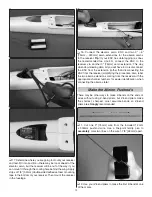
18
Prefl ight Ground Check
❏
1. Perform a
thorough
prefl ight exam, double-checking
that everything on the model is safe, sound and secure.
Pay special attention to the servos and linkages and apply
moderate pressure to all the control surfaces, ensuring that
the horns, servos and control surfaces are secure.
❏
2. Review the check list to make sure you haven’t left
anything out:
CHECK LIST
❏
ESC bullets secured to motor bullets with heat-shrink
tubing
❏
Motor securely mounted, threadlocker on screws
❏
Propeller and spinner securely mounted
❏
Motor/prop/spinner turn freely
❏
C.G. checked, battery location marked on wing saddle
❏
Throws checked, controls respond in the correct
direction
❏
Servos leads/servo extensions securely connected
to receiver
❏
Receiver antennas oriented/positioned as specifi ed
by the radio manufacturer
❏
Horizontal stabilizer screws secure with threadlocker
Set a Flight Timer
First on your agenda before fl ying should be setting a fl ight
timer based on a conservative estimate of the length of time
you can fl y. This is both so the motor does not quit unexpectedly
(causing an unplanned landing) and/or so you do not over
discharge your battery. The Rifl e isn’t your typical sport model
that drains the battery slowly. In order to achieve maximum
speed the motor and batteries are pushed near their limit
making it even
more important
to know what the limits are
and therefore when to stop. The recommended 28-45-3600
Ammo powered by either the
sport
setup or the
speed
setup
can withstand continuous, all-out, full-throttle fl ying for the
practical duration of the battery. As shown in the table at the
bottom of the page, the sport setup will draw about 34A at
full-throttle in-fl ight and the speed setup will draw about 45A
at full-throttle in-fl ight. To convert this to fl ight time, divide the
capacity you wish to drain from your battery (the size of your
“fuel tank”) by the current and convert to minutes:
You should strive to consume no more than
80%
of your
battery during a fl ight. If using the recommended 2200mAh
battery, your capacity available is then 1760mAh (2200mAh x
.8 = 1760mAh). Convert the capacity to Amp hours by dividing
by 1000; 1760mAh/1000 = 1.76Ah. For the speed setup,
divide 1.76Ah by the average, in-fl ight current (45A) to arrive
at a fl ight time of .039 hours which equals 2.35 minutes (two
minutes, 21 seconds). If using full-throttle exclusively, this is
the recommended run time for the 3S speed setup—
2:20
. If
you won’t be fl ying full-throttle exclusively, you may lengthen
your fl ight time accordingly.
Though the average, maximum current for the 2S sport
setup is 34A, it is likely that you won’t be fl ying full-throttle
the whole time as it is intended more for beginners or sport
fl ying. Practically, an average fl ight time for the sport setup is
more like 4-1/2 minutes or longer.
Set your timer accordingly. If possible, link your timer to the
throttle stick so you won’t be counting the time that you are
power off.
Tip:
If your transmitter has
two
timers, set one
timer a minute shorter than the fi nal timer to act as a “wake-
up call” alerting you that you have one minute left.
SPEED
setup
SPORT
setup
BATTERY
PROPELLER
MOTOR
MAX. CURRENT
MAX. WATTS
MAX. RPM
28-45-3600 Ammo (GPMG5220)
3S 2200mAh 30C
2S 2200mAh 30C
APC 4.5 x 4.1
APC 5.25 x 6.25
STATIC
IN-FLIGHT
STATIC
IN-FLIGHT
48A
42A - 45A
45A
34A
520W
475W
300W
230W
34,000rpm
34,400rpm
21,000rpm
21,650rpm
Summary of Contents for Rifle 1M
Page 24: ......







































